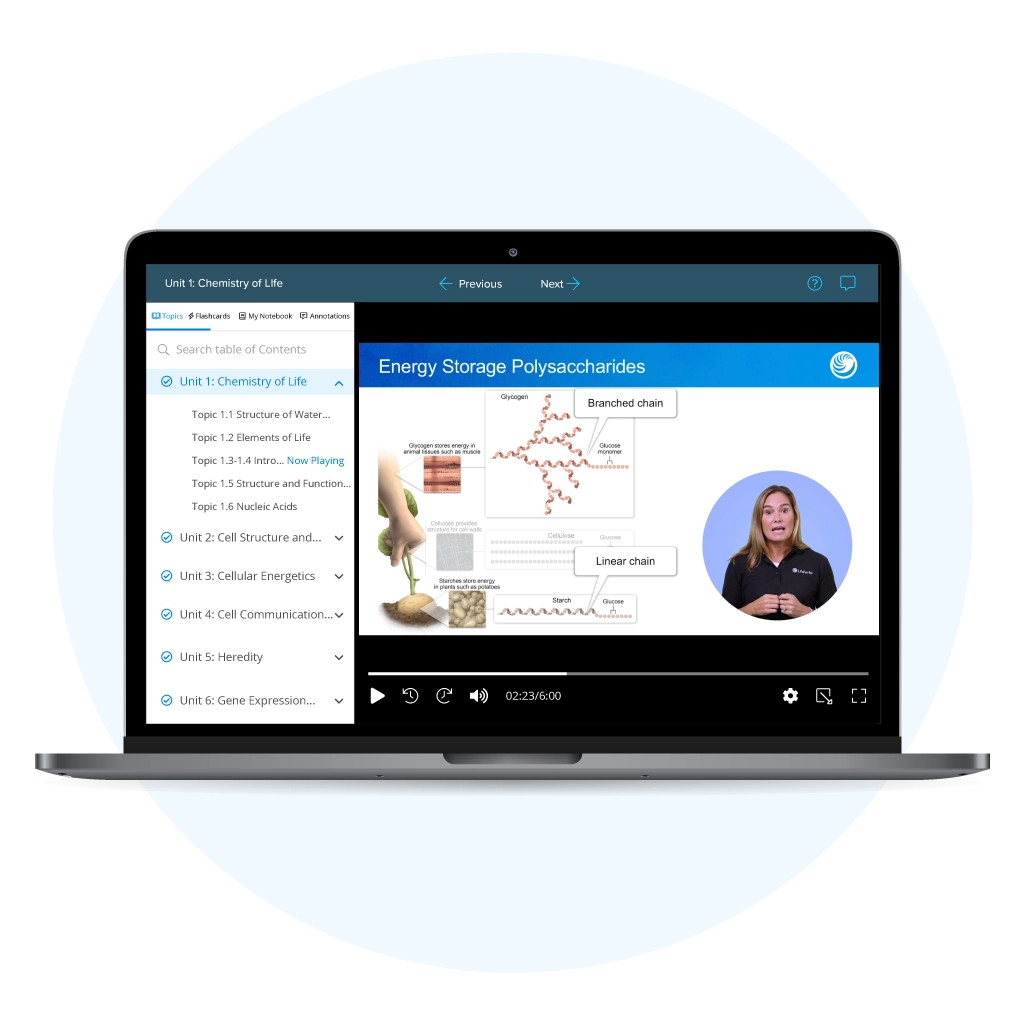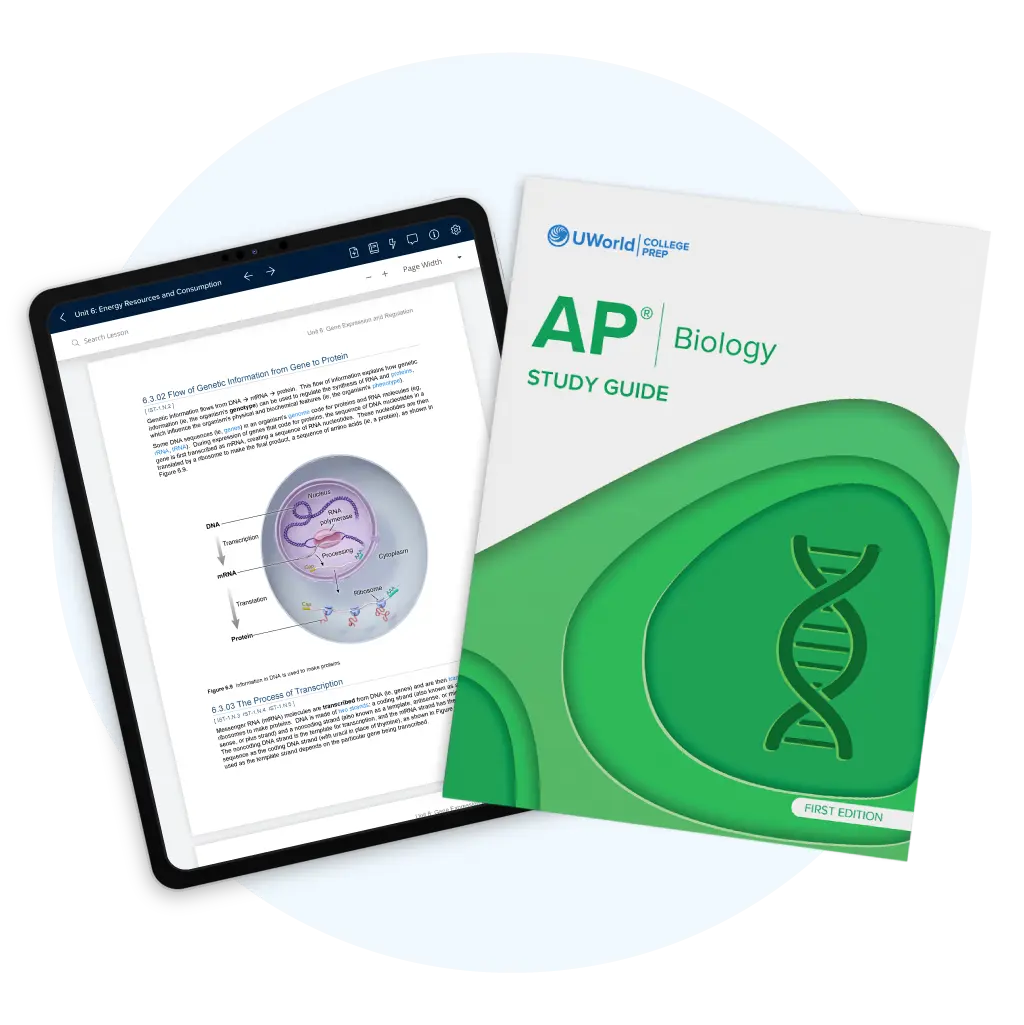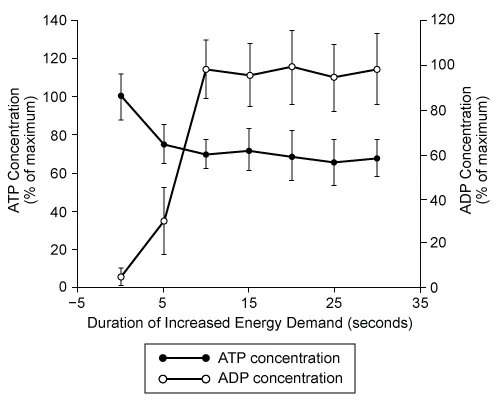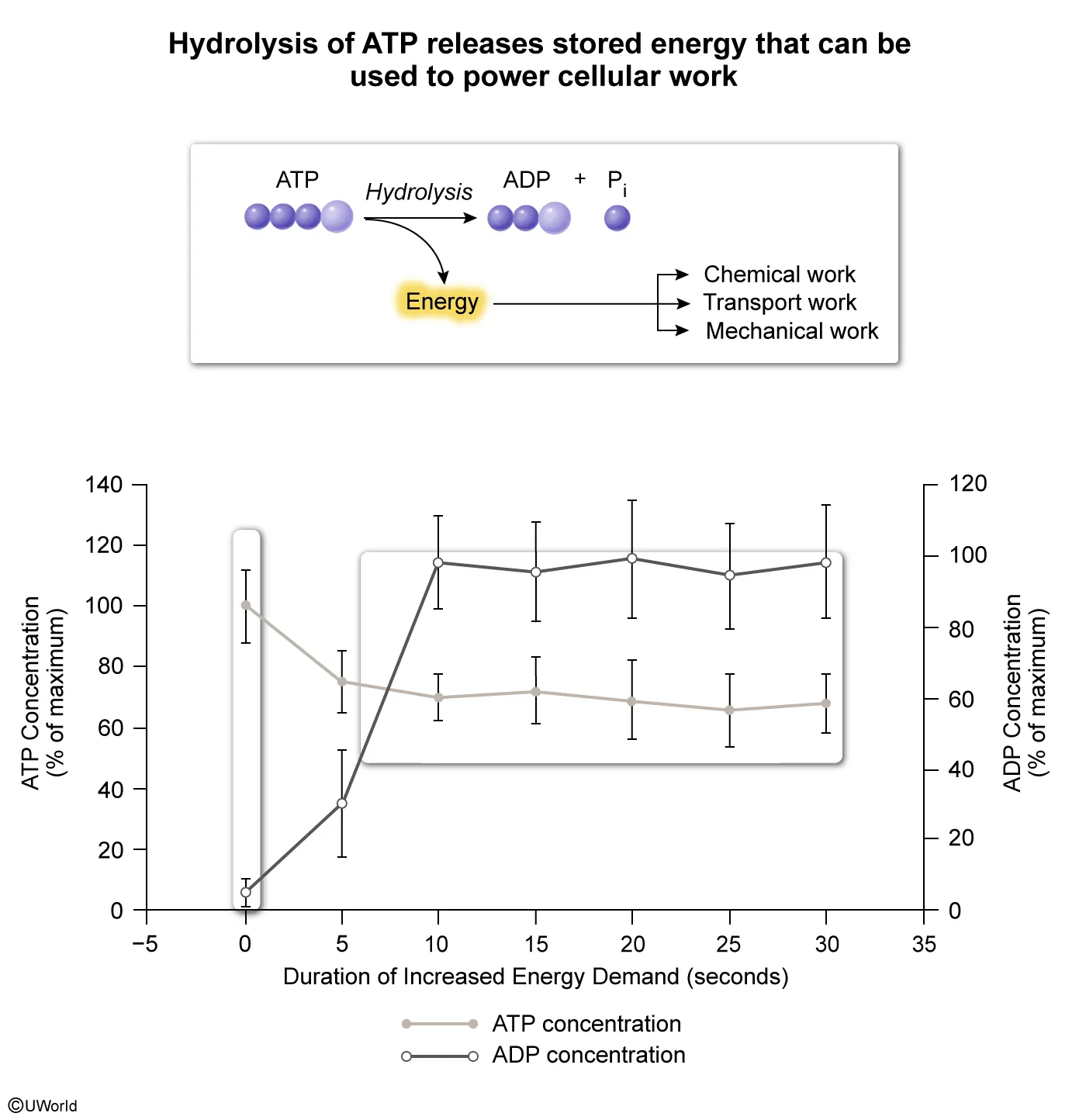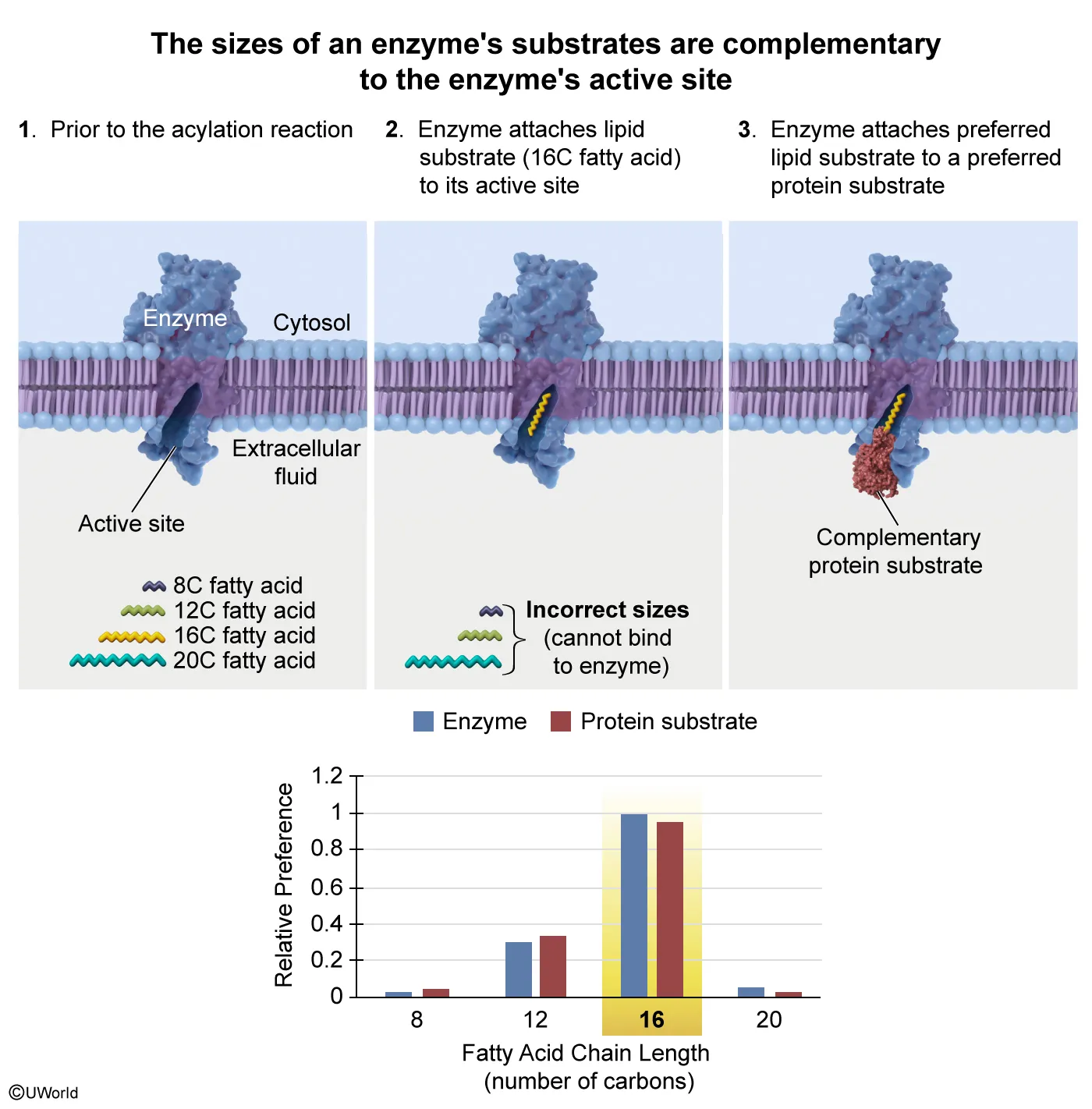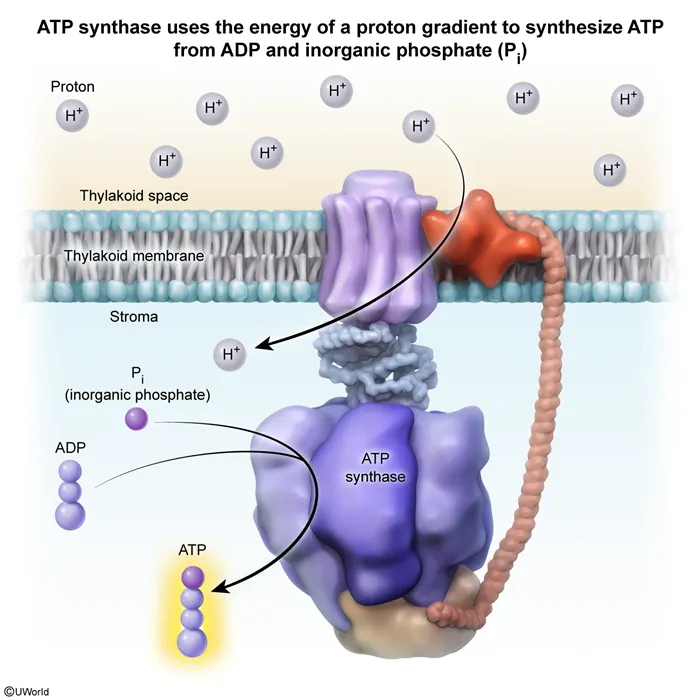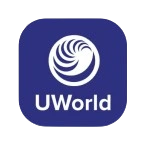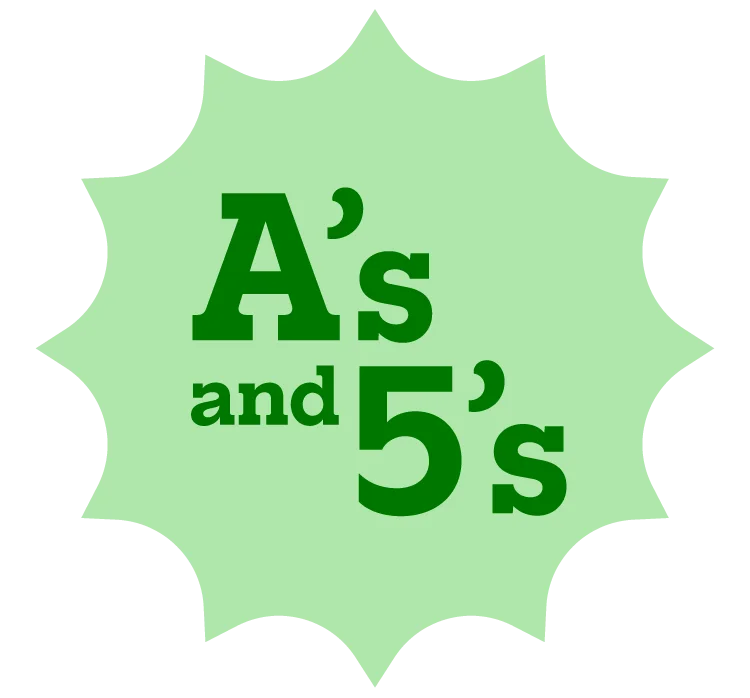AP® Biology Unit 3 Review and Practice Test
Thinking which resource to use for your AP® Biology Unit 3 review? We’ve got your back! UWorld brings you a thorough coverage of Cellular Energetics, where our AP specialists break down topics like Enzymes, Cellular Energy, Cellular Respiration, and more, to help you understand every concept with ease. So, whether you are struggling with AP Bio Unit 3 MCQs or FRQs, UWorld is the right way to go for earning a solid 5.
Boost Your Confidence and Score High with Our AP Biology Unit 3 Review
Ready to score a 5 with our Unit 3 AP® Bio review? Designed by AP subject-matter experts, our coursework includes everything that you’ve been looking for! Our study guide, question bank, video lessons, and study tools are built to help you understand even the most complex topics with ease, ensuring you learn faster, understand better, and retain longer.
Engaging Video Lessons
Still stuck with bulky, boring books? With UWorld, AP Bio Unit 3 review is now fun and interactive. Prep with short, focused, and image-rich video lessons that make learning easier and help you avoid the confusion of text-heavy explanations.
Interactive Study Guides
Our study guide covers every topic listed in the College Board® CED, so nothing catches you off guard on exam day. Each AP Bio Unit 3 topic includes an in-depth explanation of concepts, well-labeled diagrams, and checkpoints to help you reinforce what you learn.
Try These AP Biology Unit 3 Practice Test Questions
Question
Changes in ATP and ADP levels during a period of increased energy demand in a certain cell type are depicted in the graph above. Which mechanism below best predicts how the changes in ATP and ADP levels likely occur?
| A. An increasing ADP level causes a decrease in the ATP level, thereby maintaining high levels of both molecules in these cells. | |
| B. A low ADP level causes a reduction in ATP levels, which maintains low levels of both molecules in these cells. | |
| C. A period of increased energy demand stimulates ATP hydrolysis, which increases ADP levels and releases energy for metabolic processes. | |
| D. A period of increased energy demand stimulates ATP synthesis, which reduces ADP levels and releases energy for metabolic processes. |
Explanation
Adenosine triphosphate (ATP) consists of an adenine molecule with a series of three phosphate molecules attached to it. The bonds linking these phosphate groups represent a large store of potential energy that can be released to provide energy for essential cellular processes.
During cellular respiration and fermentation, cells harvest energy from organic molecules to synthesize ATP. To release this stored energy, ATP reacts with water in a process called hydrolysis. This process converts ATP to ADP and inorganic phosphate and also releases energy.
The graph in the question shows that ATP levels fall and ADP levels rise during a period of increased energy demand in a certain cell type. This response is consistent with the hydrolysis of ATP, which would increase ADP levels and provide energy to meet the increased energy demand for performing various types of work (eg, maintenance of ion gradients across membranes, activity of motor proteins, or chemical conversions).
(Choices A and B) The graph depicts an inverse relationship between ATP and ADP concentrations (ie, they change in opposite directions). In ATP hydrolysis, the increase in ADP concentration is caused by the decrease in ATP concentration, not vice versa.
(Choice D) Increased energetic demand will likely stimulate ATP hydrolysis, not synthesis. Also, ATP synthesis is an energy-requiring process.
Things to remember:
The energy stored in ATP is released on conversion to ADP and inorganic phosphate (ie, hydrolysis). This energy can be used to power cellular work.
Question
A certain enzyme catalyzes the attachment of fatty acid chains to proteins in a process called acylation. During the catalyzed reaction, the enzyme first acylates itself with the fatty acid chain before transferring it to the protein. In a research study, the chain length preferences of the enzyme and its protein substrate for binding fatty acid chains are determined. Which graph below best represents the likely results?
A.
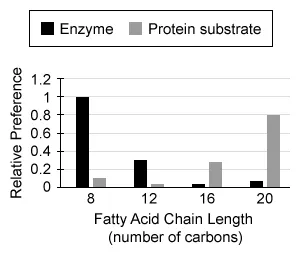
|
|
B.
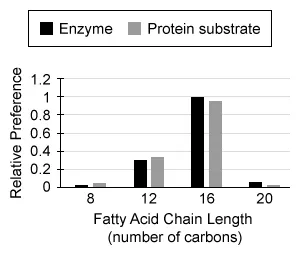
|
|
C.
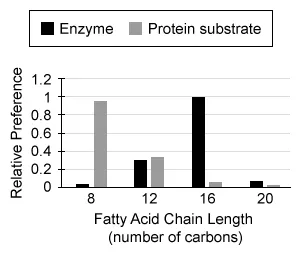
|
|
D.
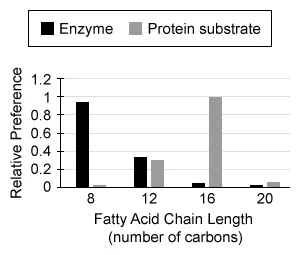
|
Explanation
Catalysts are molecules that increase the rates of chemical reactions without being consumed themselves. Enzymes are catalysts produced in living organisms. The reactant molecules upon which enzymes act are substrates, and the region on enzymes where substrates bind to undergo the reaction is called the enzyme's active site. For proper binding, the substrate must have a shape and charge complementary to the enzyme's active site.
The question describes an enzyme-catalyzed reaction in which the enzyme first attaches a lipid substrate to itself before transferring the lipid substrate to a protein. The size and shape of the lipid and protein substrates must be well-matched to the enzyme active site for binding to occur. Because the same lipid binds both the enzyme active site and the protein, both likely interact best with lipids of the same length. Therefore, the graph for Choice B, which shows both the enzyme and its protein substrate having similar chain-length preferences for 16-carbon chains, best represents the likely results.
(Choices A, C, and D) These graphs show poorly matched chain-length preferences for the enzyme and its protein substrate, which is an unlikely result since both the enzyme active site and the protein substrate bind the same lipid substrate.
Things to remember:
The shape and size of an enzyme active site must be well-matched to those of substrates for catalysis to occur.
Question
Which diagram below best represents the synthesis of ATP by ATP synthase in chloroplasts?
A.
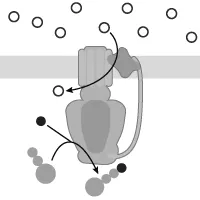
|
|
B.
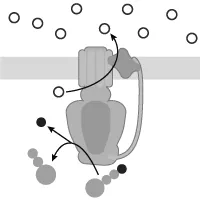
|
|
C.

|
|
D.

|
Explanation
Photosynthesis is the phototrophic transformation of light energy into chemical energy in the form of small sugar molecules. In this process, light absorption by chloroplast pigments (eg, chlorophyll) triggers electron flow through the electron transport chain connecting photosystems I and II. Water molecules are split into O2 and H+ (ie, protons), and protons are pumped from the stroma into the thylakoid space, thereby generating a proton gradient across the thylakoid membrane.
The proton gradient generated across the thylakoid membrane represents potential energy that can be harnessed by ATP synthase to power the synthesis of ATP. During this process, protons in the thylakoid space (ie, inside the thylakoids) cross the thylakoid membrane down their concentration gradient, through ATP synthase. This passage of protons causes movement of ATP synthase that results in the synthesis of ATP from ADP and inorganic phosphate. Therefore, only the diagram in Choice A correctly depicts ATP synthesis by ATP synthase.
(Choice B) During ATP synthesis, protons cross the thylakoid membrane down their concentration gradient (not against the gradient) through ATP synthase, thereby enabling the proton gradient to power the production (not breakdown) of ATP.
(Choices C and D) These diagrams show equal proton concentrations on both sides of the thylakoid membrane (ie, no gradient). A proton gradient is required for ATP synthesis by ATP synthase.
Things to remember:
Chloroplast ATP synthase requires inorganic phosphate, ADP, and a pH gradient across the thylakoid membrane to synthesize ATP.
Stand Out
with a Top Score in AP Biology
Finish your Unit 3 AP Biology review and continue mastering all units with UWorld. Boost your performance and set yourself apart as a strong candidate for competitive colleges, majors, and scholarships by earning a top score.
Get our all-in-one course today!
- Focused AP Bio Videos
- Print & Digital Study Guide
- 500+ Exam-style Practice Questions
- Customizable Quiz Generator
- Adjustable Study Planner
- Realistic Timed Test Simulation
- Colorful Visual Explanations
- Progress Dashboard
- Smart Flashcards & Digital Notebook
Hear From Our AP Students

UWorld’s service is pretty good and helps provide a lot of explanations on subjects I haven’t been confident in before.

The questions here are the most realistic to the AP tests I've seen so far! I appreciate the ability to customize tests as well.

The best part is that all options are well-explained, clearly telling why they are not the right option.
Frequently Asked Questions (FAQs)
What is AP Biology Unit 3 and why is it important for the exam?
AP Bio Unit 3 focuses on Cellular Energetics; the foundation of biological energy transfer. It explains how cells capture, store, and use energy to sustain life. This unit is heavily tested in both the AP Biology Unit 3 FRQ and AP Biology Unit 3 Progress Check MCQ sections of the official AP Biology Unit 3 test.
Students who understand how enzymes regulate reactions, how ATP stores and releases energy, and how photosynthesis and cellular respiration interconnect perform better across every AP Bio Unit 3 progress check and AP Bio Unit 3 test. These concepts also reinforce future units on cell communication and homeostasis.
UWorld’s AP Biology Unit 3 study guide helps students visualize energy flow through labeled diagrams, data-driven explanations, and test-style questions modeled on College Board logic. When paired with official College Board materials and Khan Academy videos, UWorld offers a complete system for mastering cellular energetics and excelling on the AP Biology Unit 3 exam.
What topics are covered in Unit 3 AP Bio?
Unit 3 AP Bio covers the complete scope of Cellular Energetics. Every subtopic appears in AP Bio Unit 3 MCQs and Unit 3 AP Biology FRQs, testing both factual knowledge and reasoning.
Core areas include:
- Enzyme function, specificity, and inhibition
- Energy transfer through ATP hydrolysis and electron carriers
- Cellular respiration (glycolysis, Krebs cycle, electron transport chain, and chemiosmosis)
- Photosynthesis (light-dependent reactions and the Calvin cycle)
- Thermodynamics, energy coupling, and metabolic regulation
Students preparing for the AP Bio Unit 3 should focus on connecting structure to function; how enzymes, membranes, and energy molecules interact. The UWorld AP Biology Unit 3 review combines visual flowcharts and guided practice questions that mimic College Board testing patterns, helping you build reasoning and fluency before the real exam.
What’s the most effective way for a quick AP Bio Unit 3 review?
Effective AP Bio Unit 3 review starts with comprehension, then moves toward active recall. Read theory from your AP Bio Unit 3 study guide, visualize reactions, and test immediately with practice MCQs or FRQs. Avoid rereading notes; instead, summarize each process aloud in your own words.
A practical sequence:
- Learn the basics of enzymes, ATP, and energy transfer.
- Apply this knowledge through data-based AP Bio Unit 3 progress check MCQs.
- Revisit concepts through spaced recall every few days.
UWorld’s AP Biology Unit 3 review system encourages this cognitive cycle by pairing visuals with reasoning questions that resemble real exam formats. Integrating College Board progress checks and Khan Academy conceptual videos alongside UWorld’s explanations helps build mastery that lasts.
How do I manage time across weeks without burning out for AP Bio Unit 3?
Create consistency instead of long cram sessions. Divide content into short, focused cycles that mix reading, visualization, and recall. Begin with review questions rather than finishing with them so your brain stays active from the start.
Weekly Plan
- Day 1: Enzyme function and inhibition
- Day 2: Energy coupling and thermodynamics
- Day 3: Cellular respiration and ATP yield
- Day 4: Photosynthesis and electron transport
- Day 5: FRQs and progress check MCQs
- Day 6: Review errors and summarize key points
- Day 7: Light recall only
Track daily accuracy. If one topic lags, increase its frequency rather than time. Adaptive dashboards such as those used in UWorld help identify weak areas and prevent wasted effort.
What are the main AP Biology Unit 3 FRQ question types?
The AP Bio Unit 3 FRQs test your ability to apply reasoning. Typical prompts include analyzing enzyme regulation, predicting the effects of temperature or pH on reaction rate, or interpreting data from respiration and photosynthesis experiments.
Each FRQ should follow the Claim-Evidence-Reasoning format:
- State a clear claim.
- Support it with data or process evidence.
- Link the evidence to the biological mechanism.
UWorld’s AP Biology Unit 3 FRQ practice bank models the scoring logic used by the College Board, showing how to craft concise, evidence-based answers that earn full credit on Unit 3 AP Bio FRQs.
How can I retain long pathways like glycolysis and oxidative phosphorylation?
Retention depends on simplification and repetition. Divide each pathway into input, process, and output, then repeat them until they form a clear sequence. Write the steps once, then test yourself backward to ensure logic, not memory, drives recall.
Use a spaced repetition schedule: review one day later, three days later, and one week later. Add quick recall drills after each session to strengthen storage. Visual learners can color-code molecules or electron carriers for clarity. Study platforms that pair step diagrams with active quizzes, such as UWorld’s AP Biology Unit 3 study guide, reinforce long-term retention through visual and cognitive repetition.
How do I study enzyme function for the AP Biology Unit 3 test?
Enzymes are the foundation of AP Biology Unit 3, appearing frequently in AP Bio Unit 3 FRQs and AP Bio Unit 3 MCQs. To prepare effectively, focus on understanding how structure determines function. Study how temperature, pH, and substrate concentration affect reaction rates, and learn to interpret enzyme rate curves.
Draw graphs from memory to practice identifying optimal conditions and denaturation points. When reviewing inhibitors, distinguish between competitive and noncompetitive inhibition, explaining how each changes the rate curve and reaction outcome.
UWorld’s AP Biology Unit 3 practice questions mirror the experimental reasoning style of College Board exams. Each explanation connects enzyme structure to real biological mechanisms, reinforcing understanding through visual diagrams and targeted question sets.
How are photosynthesis and cellular respiration connected in AP Bio Unit 3?
Photosynthesis and cellular respiration work as complementary processes in the biological energy cycle. Photosynthesis captures light energy to produce glucose, while respiration releases that stored energy to power cellular activity. Together, they form the foundation of AP Biology Unit 3 and appear consistently across AP Bio Unit 3 practice tests, FRQs, and MCQs on cellular energetics.
To study effectively, track how ATP, NADH, CO₂, and O₂ move between both systems. The oxygen and glucose produced through photosynthesis drive respiration, while respiration’s carbon dioxide and water return to support photosynthesis. Understanding this exchange helps you approach data-based questions with precision and connect patterns between the two processes.
UWorld’s AP Biology Unit 3 cellular energetics lessons simplify this link through visuals, experimental analysis, and scaffolded reasoning. The platform’s built-in AP Bio Unit 3 progress check MCQs and adaptive FRQs quietly integrate AI-driven feedback, helping students refine explanations the same way College Board scorers evaluate logic. Practicing these alongside official materials creates balanced, exam-level readiness for all AP Bio Unit 3 practice tests.
What is the best AP Bio Unit 3 practice test format to use while studying?
The most effective AP Bio Unit 3 practice test is one that replicates the exam’s analytical format. Look for question sets that mix data interpretation, experiment-based reasoning, and conceptual application rather than simple recall.
A high-quality AP Biology Unit 3 practice test should include:
- Experimental setups on enzymes, respiration, and photosynthesis
- Graphs requiring variable analysis
- FRQ-style questions that train you to justify claims with evidence
UWorld’s AP Biology Unit 3 practice tests simulate the timing, complexity, and tone of real AP exams. They teach you how to analyze visuals, interpret results, and apply knowledge; skills directly transferable to official College Board assessments.
Where can I find AP Bio Unit 3 notes, cheat sheets, or study guides?
The best AP Bio Unit 3 notes and AP Bio Unit 3 cheat sheets summarize complex topics like cellular respiration, enzyme activity, and photosynthesis into visual frameworks. Concise review sheets help during the final week before your Unit 3 AP Biology test, when you need rapid recall without lengthy reading.
UWorld’s AP Biology Unit 3 study guide functions as an interactive alternative to static notes. It includes labeled diagrams, stepwise breakdowns of glycolysis and oxidative phosphorylation, and explanations that simplify hard-to-visualize reactions. Pairing these with College Board topic outlines and Khan Academy refresher videos creates an efficient end-stage review cycle.
Are there any downloadable AP Biology Unit 3 study guide PDFs and practice materials?
Yes. UWorld offers downloadable AP Biology Unit 3 study guide PDFs designed for offline review. These guides combine short explanations, visuals, and self-check quizzes for independent study. They complement UWorld’s online AP Biology Unit 3 practice tests, which replicate College Board’s question format.
Students typically use these PDFs to reinforce learning from digital practice sessions, making them ideal for travel or last-minute study. Additionally, pairing UWorld’s downloadable materials with official College Board progress checks and Khan Academy concept videos ensures complete preparation for every AP Bio Unit 3 FRQ, MCQ, and practice scenario.
What are common mistakes students make in AP Biology Unit 3?
Students often lose points on AP Biology Unit 3 practice questions by misinterpreting data or oversimplifying biological relationships. Typical issues include:
- Confusing inputs and outputs between photosynthesis and respiration
- Misreading enzyme activity graphs
- Overlooking how inhibitors affect reaction rate
- Ignoring ATP coupling in metabolic pathways
Avoid memorizing definitions in isolation. Instead, focus on understanding how processes connect; how energy transfer underpins every system in the unit. UWorld helps correct these misconceptions by showing detailed reasoning for every answer option. Each AP Bio Unit 3 practice test and question explanation reinforces logical understanding until pattern recognition becomes instinctive.
How can I raise my score on AP Biology Unit 3 FRQs?
Strong FRQ responses show reasoning, not memorization. Read sample rubrics and notice that graders reward logical structure. Each point comes from a clear connection between process and outcome. Begin your preparation by practicing the “Claim, Evidence, Reasoning” model. Each answer should start with a direct statement, followed by specific data or explanation, and end with a reason linking cause and effect.
During study sessions, rewrite FRQs after grading them. Eliminate filler and strengthen verbs. Replace vague claims such as “enzymes help reactions” with “enzyme structure stabilizes transition states, lowering activation energy.” Over time, your writing becomes precise and efficient.
Using a guided question bank like UWorld’s FRQs helps refine argument flow and align your logic with the College Board’s scoring expectations..
What type of AP Biology Unit 3 practice test prepares you for data-based questions on the real exam?
The most effective AP Biology Unit 3 practice test replicates the data interpretation format you’ll face on exam day. These questions test reasoning under time pressure, not fact recall. Start by reviewing tests that feature graph analysis, experimental results, and quantitative trends tied to enzyme activity, respiration, and photosynthesis.
When practicing, always apply a methodical approach:
- Read the axes first to define what is being measured.
- Identify the manipulated and responding variables.
- Describe the overall trend: rising, steady, or declining.
- Link each pattern to a biological mechanism such as enzyme denaturation or proton gradient disruption.
- Finish with a one-sentence prediction that explains the outcome biologically.
This process forces analysis instead of description. UWorld’s AP Biology Unit 3 practice tests follow this exact design, using multi-step experimental scenarios that strengthen both timing and analytical accuracy. Practicing with these questions consistently builds the precision needed for high performance on data-based FRQs and AP Bio Unit 3 progress check MCQs, reinforcing your understanding of concepts like Cellular Energetics as a complete system.
Where can I find AP Bio Unit 3 practice tests, MCQs, and Progress Checks?
You can access AP Bio Unit 3 practice tests through multiple reliable sources. The College Board’s AP Classroom provides official Progress Check MCQs and FRQs, which are ideal for benchmarking your understanding. However, to move beyond memorization and build exam-level reasoning, you need practice that explains why each answer is right or wrong, not just which one.
UWorld’s AP Biology Unit 3 question bank is designed for that deeper learning. Its questions mirror the tone, logic, and complexity of the real exam, featuring:
- Data-driven scenarios and experimental setups with graphical analysis
- Multi-step reasoning modeled after College Board progress checks
- Full-length digital mock exams and customizable quizzes targeting key areas like enzyme function, cellular respiration, and photosynthesis
Every question in UWorld includes an in-depth rationale supported by visuals, annotations, and definitions that turn review into active learning. Built-in analytics track accuracy trends over time, helping students pinpoint strengths and address weak spots across enzyme kinetics, ATP generation, and energy coupling; the most tested themes in AP Biology Unit 3.

